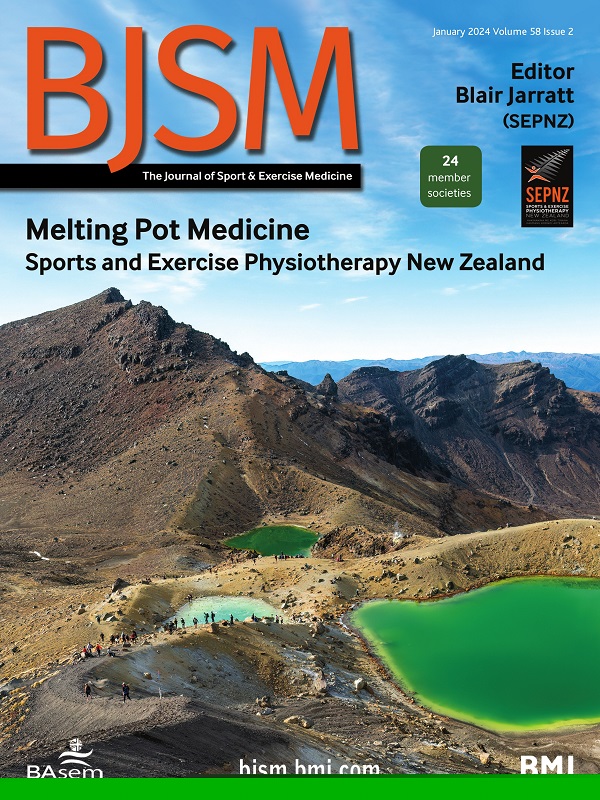为什么它会起作用?在足球和手球中基于运动的损伤预防方案的生物医学效应机制:104项研究的范围综述
IF 16.2
1区 医学
Q1 SPORT SCIENCES
引用次数: 0
摘要
目的探讨足球和手球运动损伤预防方案的生物医学效应机制。设计对随机对照试验(RCT)、队列研究和案例研究进行范围评估。从2000年到2024年,检索了PubMed、SPORTDiscus和Web of Science数据库中的MEDLINE数据库。如果研究描述了足球或手球运动中基于运动的伤害预防方案,并提供了生物医学原理或效果机制的主张,则纳入研究。所有年龄和性别的精英、亚精英或业余水平的同行评议研究都符合条件。我们纳入了104项研究(78项随机对照试验,25项队列研究,1项病例研究),样本量从10到4556名参与者不等。大多数研究(83%)发表于2010年之后,82%的研究报告称干预措施有效果。四个主要主题描述了提出的效应机制:神经肌肉控制(47%),力量(39%),运动范围(11%)和身体健康(3%)。只有19%的研究提供了与干预相关的关键术语的定义,只有59%的研究进行了特定生物医学效应机制的测量。结论神经肌肉控制和力量是足球和手球运动损伤预防的主要作用机制。为了更好地建立运动干预的效果机制,未来的研究应该一致地定义与干预相关的关键术语,并努力识别和测试因果机制,以优化损伤预防方案。所有与研究相关的数据都包含在文章中或作为补充信息上传。本文章由计算机程序翻译,如有差异,请以英文原文为准。
Why does it work? Proposed biomedical effect mechanisms of exercise-based injury prevention programmes in football (soccer) and handball: a scoping review of 104 studies
Objective To describe the proposed biomedical effect mechanisms in research on exercise-based injury prevention programmes in football (soccer) and handball. Design Scoping review of randomised controlled trials (RCT), cohort studies and case studies. Data sources MEDLINE via PubMed, SPORTDiscus and Web of Science databases were searched from 2000 to 2024. Eligibility criteria Studies were included if they described exercise-based injury prevention programmes in football (soccer) or handball and provided a biomedical rationale or proposition of effect mechanisms. Peer-reviewed studies of all ages and both sexes at elite, subelite or amateur level were eligible. Results We included 104 studies (78 RCTs, 25 cohort studies, 1 case study) with sample sizes ranging from 10 to 4556 participants. Most studies (83%) were published after 2010, and interventions were reported to have an effect in 82% of the studies. Four main themes emerged describing the proposed effect mechanisms: neuromuscular control (47%), strength (39%), range of motion (11%) and physical fitness (3%). Definitions of key terms related to the intervention were provided in only 19% of studies, measurements of specific biomedical effect mechanisms were conducted in just 59% of studies. Conclusion Neuromuscular control and strength were the predominant proposed effect mechanisms for injury prevention programmes in football and handball. To better establish effect mechanisms of exercise-based interventions, future research should consistently define key terms related to the interventions and strive to identify and test causal mechanisms to optimise injury prevention programmes. All data relevant to the study are included in the article or uploaded as supplementary information.
求助全文
通过发布文献求助,成功后即可免费获取论文全文。
去求助
来源期刊
CiteScore
27.10
自引率
4.90%
发文量
217
审稿时长
3-8 weeks
期刊介绍:
The British Journal of Sports Medicine (BJSM) is a dynamic platform that presents groundbreaking research, thought-provoking reviews, and meaningful discussions on sport and exercise medicine. Our focus encompasses various clinically-relevant aspects such as physiotherapy, physical therapy, and rehabilitation. With an aim to foster innovation, education, and knowledge translation, we strive to bridge the gap between research and practical implementation in the field. Our multi-media approach, including web, print, video, and audio resources, along with our active presence on social media, connects a global community of healthcare professionals dedicated to treating active individuals.

 求助内容:
求助内容: 应助结果提醒方式:
应助结果提醒方式:


